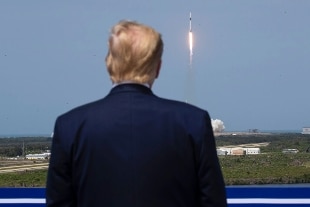- Crew Dragon has left. The US returns to space
- Once the Crew Dragon has started, the US returns to space
- United States: SpaceX Falcon 9 launched in Cape Canaveral, Florida
Share
May 30, 2020 With his presence at the launch of the SpaceX Crew Dragon from Cape Canaveral, Florida, President Donald Trump marks the return of the United States in the race for Space, the next game for global, military and commercial supremacy. The Demo-2 mission represents the first transport of astronauts into orbit from American soil in nearly a decade. It took place, on his second attempt, at 9:22 pm (Italian time) from the Kennedy Space Center, the same location as the last US mission to the Moon.Like the then President John Kennedy who revealed US intention to go to the moon on September 12, 1962 at Rice University in Houston, Texas, Trump used the State of the Union speech on February 4 to announce to Americans the new challenge of man to the universe. During his speech in Congress, the commander-in-chief had turned to a 13-year-old boy, Iain Lanphier, who had come from Arizona with the dream of joining the Space Force one day. "Iain, please get up," the president urged him, who then spoke of the "Artemis" program, Apollo's 'sister', with which NASA aims to send astronauts to the Moon by 2024 and to Mars in the next decade. . At the beginning, the times were longer, there was talk of 2028, but Trump asked to speed up, shortening the deadline by at least four years.
The last trip to the moon was that of Apollo 17, in 1972. This time NASA wants to transport the machines first and then the astronauts, sending two non-pressurized "rovers" for space excursions and designed to be piloted remotely. . Compared to the Apollo missions, the astronauts would stay on the moon twice as long, about 6 and a half days, during which four "walks" would be carried out to make samples of the soil and, above all, ice. In the South Pole of the Earth's satellite, according to NASA, there are areas that have always remained in the shadows, where ice may have been preserved for thousands of years. But they also affect "light zones", such as those on the edge of the Shackleton crater, which could store an extraordinary amount of solar energy. The mission is the launching pad for Trump's even more ambitious goal, which is firmly rooted in the dream of Tesla's founder, Elon Musk, the first private investor in history to collaborate with NASA: to bring millions of people to live one day on Mars, as in a Ray Bradbury novel. The synergy with private individuals, as shown by the collaboration with Musk, is considered important to finance a project that foresees an average cost between 6 and 8 billion dollars per "trip", part of which would be covered by the 20 billion provided to NASA.
Trump last year attempted to draw money from the Pell Grant Reserve Fund, which provides subsidies for low-income students, but found opposition from the Democrats. The president will return to office: Space is the domain on which he wants to reaffirm the American primacy over China and Russia. Not only the leadership among the stars is at stake, but the control of the satellite systems of civil and military communication, and navigation, starting with the latest generation GPS.
How much Trump is keen to make Space "his" dominion, is confirmed by the obstinacy with which he asked NASA to design a new logo, to mark a change of pace and associate it with his presidency. The symbol, presented at the White House, has generated irony because it recalls the Star Trek style and perhaps it is no coincidence: cinema is very present in Trump's cosmology. His campaign has chosen to focus on Star Wars, comparing the president's future electoral power to the Black Death, the "dark weapon" of the Hollywood saga. Its manager, Brad Parscale, has announced the arrival of Star Wars-style special effects. One should be the new challenge among the stars, which will see Trump on the front row tonight at the mythological space base in Florida. (AGI) NWY / Ril

